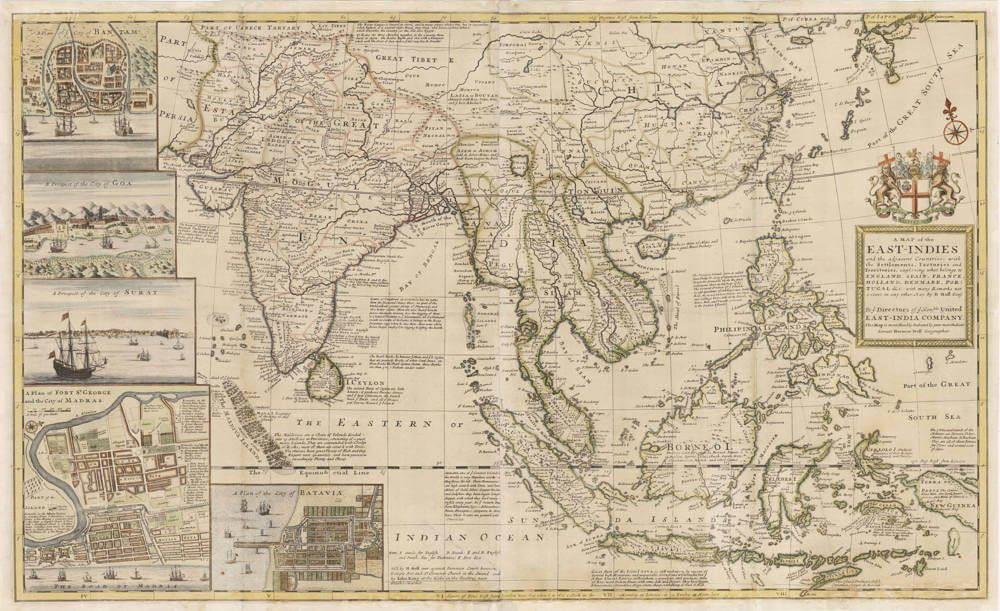Leen Helmink Antique Maps & Atlases
www.helmink.com
Moll
A Map of the East-Indies and the Adjacent Countries; with the Settlements, ...
Certificate of Authentication and Description
This is to certify that the item illustrated and described below is a genuine antique
map, print or book that was first produced and published in 1710, today 315 years ago.
April 19, 2025
Cartographer(s)
Moll
First Published
London, 1710
This edition
London, ca 1720
Size
62 x 105 cms
Technique
Copper plate engraving
Stock number
19641
Condition
very good


Description
The first large-scale map of Southeast Asia published in England.
Herman Moll's expansive and decorative map of India, Southeast Asia, China, and the Philippines, published in the 18th century, stands out as one of the era's most sought-after maps. This was the first large-scale map of the region produced in England, extending from Persia to New Guinea and including parts of Japan.
The map includes detailed insets of the strategic trading posts of Bantam (Dutch), Goa (Portuguese), Surat (British), Madras (British), and Batavia (Dutch), the footholds of various European powers at the peak of their influence. The map is richly annotated with information about local produce and markets. These annotations highlight the commercial and political landscape of the time, especially the dominance of the British East India Company (EIC), which by 1720 was responsible for 15% of Britain's imports.
The EIC's journey from its inception in 1600, with a royal charter from Queen Elizabeth I, to its establishment in key Indian locations like Surat, Bombay, and Calcutta, is well documented on the map. It showcases both the EIC's commercial exploits in gems, textiles, and tea, and the diplomatic challenges faced, such as the tension with Emperor Aurangzeb over pirate activities.
Moll's cartography is a geographical guide but also as a testament to the EIC's economic and political might, cleverly designed to garner favor from the Company's influential investors. The map, explicitly dedicated to the EIC's directors, was both a commercial as well as an artistic endeavor, showing the highly competitive environment where the Dutch, Portuguese, and Spanish also held significant territories.
The map was the most popular and authoritative general cartographic representation of South and East Asia published during this period when the activities of the East India Company had risen to the forefront of the economic life of the British Empire. The EIC's arms appear on top of the title cartouche, in the far right of the map.
Condition
A good imprint of the map. Small tear repaired in lower center. Edges strengthened as always, because the map's large size. Here in attractive original colour.
Herman Moll (1654-1732)
Herman Moll, born around 1654 in Bremen, Germany, was a notable cartographer during the late 17th and early 18th centuries. His work played a role in mapping the world during a time when exploration and scientific discovery were on the rise.
Early Life and Beginnings
Little is known about Moll's early years, but it is known that he moved to London in the late 1670s or 1680s. This move was crucial as London was becoming a hub for geographical and scientific knowledge. Moll began his career as an engraver, initially for other cartographers, which gave him the necessary skills and connections to establish himself in the field.
Cartographic Career
Moll started creating his own maps at the beginning of the 18th century. His "Thesaurus Geographicus" of 1695 was one of his initial projects, followed by "A Set of Fifty New and Correct Maps of England and Wales" in 1708. These works showed a focus on detail and included political and historical context.
Moll's maps were characterized by their decorative elements like borders and cartouches, with smaller inset maps for detailed views of significant areas. His maps of the Americas, particularly those of North America, were influential as they incorporated the latest geographical discoveries and were updated frequently to reflect new findings.
Contributions and Notable Works
One of Moll's most famous works was "The World Described," published in 1715, which was essentially an atlas offering a comprehensive view of the known world at the time. This atlas was regularly updated with new editions throughout his life, showing his commitment to accuracy and relevance. Another significant publication was his "Atlas Minor," which aimed at a broader audience by providing concise, yet detailed, maps.
Moll's map of the British Isles, "A New and Exact Map of the Dominions of the King of Great Britain," from 1715, is particularly noteworthy. It not only depicted geographical features but also included postal routes, which was innovative for its time, reflecting the growing postal service and the need for more practical applications of cartography.
The Large Map of the East Indies
Moll produced "A Map of the East-Indies and the Adjacent Countries" around 1715, dedicated to the directors of the British East India Company. This map depicted the extent of European influence in the East Indies, with insets of trade hubs like Bantam and Madras, reflecting the commercial interests of the period.
Later Years
Moll's later years saw him continuing his work, although his health might have declined, as suggested by less frequent publications. He died in 1732 in London, leaving behind a body of work that influenced cartography for decades. His maps were used in schools, by explorers, and in government offices, aiding in both education and the practical administration of territories.